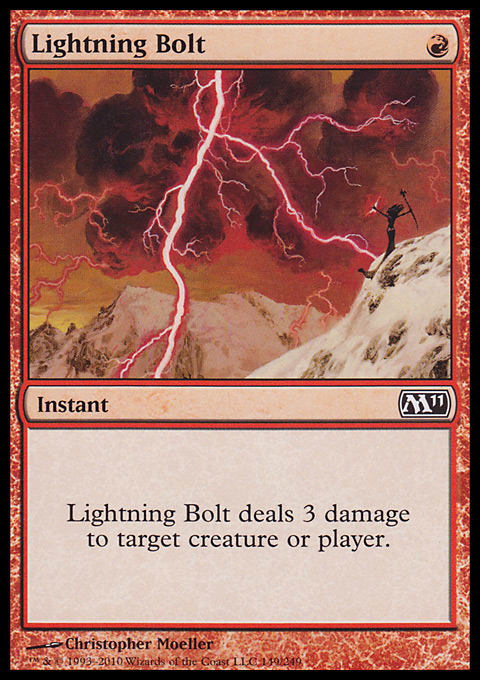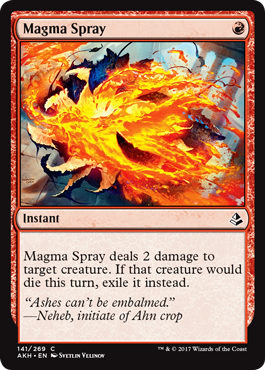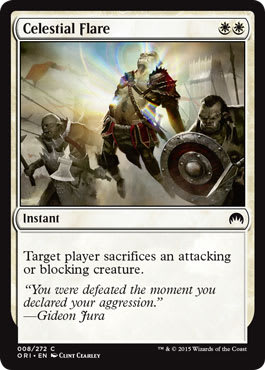Over the past four weeks something amazing has happened in Pauper. For the first time in as long as I can remember each week had a different deck as the post popular 5-0. Delver, Affinity, Kuldotha Tokens, and Dimir Flicker have topped the standings over the past month. While some of these are more popular others — Dimir Flicker has only just now topped 3% of the total undefeated metagame — the shift seems to indicate a fluid and dynamic metagame.
Dimir Flicker ? Pauper | In2theriver, 5-0 Pauper League
- Creatures (14)
- 2 Archaeomancer
- 4 Chittering Rats
- 4 Mulldrifter
- 4 Sea Gate Oracle
- Instants (14)
- 1 Echoing Decay
- 1 Exclude
- 1 Reaping the Graves
- 2 Disfigure
- 2 Ghostly Flicker
- 3 Doom Blade
- 4 Counterspell
- Sorceries (9)
- 1 Unearth
- 4 Chainer's Edict
- 4 Preordain
- Enchantments (1)
- 1 Dead Weight
- Lands (22)
- 5 Swamp
- 6 Island
- 1 Barren Moor
- 1 Lonely Sandbar
- 1 Radiant Fountain
- 4 Dimir Aqueduct
- 4 Dismal Backwater
- Sideboard (15)
- 2 Aura Flux
- 1 Dispel
- 4 Hydroblast
- 2 Relic of Progenitus
- 3 Shrivel
- 3 Stormbound Geist
These shifts are a far cry from previous seasons where Delver or (more recently) Peregrine Drake decks were basically a lock to sit atop the scrum. While familiar for other formats it is a relatively new phenomena in Pauper. In the past one could simply run the same deck every week and expect a reasonable amount of success. Set releases would often introduce a new wrinkle or two but eventually the landscape would settle and the old favorites would rise back to the top. The returns are still early but this no longer looks to be the way of things.
As a case study let’s examine Stompy. Stompy has been one of the premier aggressive strategies in Pauper for much of the past year. It is one of Pauper’s Red Decks in that it runs cards with a high damage to cost ratio and relentlessly assails life totals. Replace Rancor with Hammer of Bogardan and Vines of Vastwood with Fireblast and it looks a lot like a Tempest era Sligh deck.
Stompy ? Pauper | Double Vision, 5-0 Pauper League
- Creatures (27)
- 1 Shinen of Life's Roar
- 2 River Boa
- 2 Silhana Ledgewalker
- 3 Skarrgan Pit-Skulk
- 3 Vault Skirge
- 4 Nest Invader
- 4 Nettle Sentinel
- 4 Quirion Ranger
- 4 Young Wolf
- Instants (13)
- 2 Mutagenic Growth
- 3 Hunger of the Howlpack
- 4 Groundswell
- 4 Vines of Vastwood
- Enchantments (4)
- 4 Rancor
- Lands (16)
- 16 Forest
- Sideboard (15)
- 3 Epic Confrontation
- 4 Gleeful Sabotage
- 2 Gut Shot
- 2 Natural State
- 4 Scattershot Archer
Stompy has thrived due in part to its raw power but also because it is able to run threats that resist commonly played removal. Lightning Bolt and Chainer's Edict have been abundant in recent months and, between pump spells and Young Wolf, Stompy came prepared. The rise of Kuldotha Tokens and the lack of Peregrine Drake has given rise to the relevance of another removal spell which has helped to mitigate the efficacy of Stompy’s assault.
Journey to Nowhere can handle everything out of Stompy aside from a Silhana Ledgewalker. The Zendikar staple represents the third corner of a removal triangle that helps to define Pauper. While White is sometimes maligned as the worst color in Pauper the evidence seems to suggest otherwise as Journey to Nowhere serves as an important safety valve in the format, as do Chainer's Edict and Lightning Bolt.
These three spells represent the removal triangle of Pauper. They are representative of their respective colors and styles of play. In my experience at any given time Pauper is defined in part by which two are strong and which one is weak. To better explain my point let us take a look at the different spells and their support.
Lightning Bolt
The acme of removal in Pauper and formats beyond Lightning Bolt is emblematic of Magic in many ways. In Pauper there is no better way to handle an early creature at the end of your opponent’s turn. Lightning Bolt, and by proxy Red removal, is best at handling the smaller threats in the format. They also excel at helping to end games for decks that apply pressure early but then may falter when it comes to the final few points. Lightning Bolt is fantastic for its flexibility but Galvanic Blast and Firebolt are not far behind.
Yet even though I believe Lightning Bolt defines Red removal the best kill spell in Red’s arsenal may just be Flame Slash. While limited as a sorcery it hits more threats including Spire Golem, Myr Enforcer, and Carapace Forger. The downside is that Flame Slash is unable to be aimed directly at a life total. It also struggles against threats outside the range so Gurmag Angler, Gearseeker Serpent, and Fangren Marauder easily survive the flames. Lightning Bolt and its ilk are best suited for decks that want to use all modes while Flame Slash is suited for decks that want to determine board position.
Red also has access to more specialized removal spells. Magma Spray and Pillar of Flame help to remove threats with Undying or death triggers while conveniently keeping things out of the graveyard. Skred may be the best removal spell that sees minimal play but has the upside of taking out nearly any threat. Harvest Pyre sees some play in slower decks running Mountains as a way to handle big beaters that conveniently helps curtail a graveyard for a card like Haunted Fengraf. Burst Lightning has the advantage of two modes but is slightly overcosted in both so that helps to keep it on the sidelines. Lightning Axe has the upside of taking out Angler sized monsters for a single mana (and a second card) but in the late game becomes a solid, if expensive, option. Twin Bolt and Arc Lightning give Red access to card advantage against smaller creatures. Electrickery fills a similar role but can also be used board wipe against tokens.
Red has access to a few other potent sweepers. Swirling Sandstorm takes some effort to set up but can take out every non-Serpent, non-Crusher commonly played ground pounder. The aforementioned Electrickery occasionally sees maindeck play in aggro heavy environments. Martyr of Ashes has seen play at various points in Pauper’s history while Krark-Clan Shaman finds its way into the sideboards of Affinity with some regularity.
Red spells that may deserve another look include Dual Shot, Galvanic Bombardment, and Boiling Earth. Dual Shot is a restricted version of Twin Bolt but at half the cost. Galvanic Bombardment strikes me as the kind of card people want Skred to be — a scalable kill spell that gets better as the game goes on. Boiling Earth (and to a lesser extent Subterranean Shambler) are potential Tremors with bodies attached. While neither is exactly impressive they are more than capable of filling a needed role.
Red removal thrives in known metagames. Cards like Lightning Bolt are never bad since they can also reduce a life total but a card like Flame Slash is going to look mighty silly if Stormbound Geists and Gurmag Anglers are everywhere. Similarly Red removal tends to shine at times when the format trends aggressive as its can help to both end the game and protect a life total, often at instant speed. The low cost of Red spells also makes them prime candidates for times when the format wants to go wide with smaller threats as it is very easy to double up on removal spells during the developing stages of play. Firebolt’s value goes up as the length of game goes down.
Despite being stronger when the field of battle is established there are still times when relying on Red spells is wrong. When the threats are too large or too resilient it is time to look for something that doesn’t deal with fire, bolts, or lightning. In metagames where there are strong defensive decks Red removal is less attractive as these builds can often turn off the “kill your opponent” mode on many Red spells. Regardless of Swirling Sandstorm, when decks try to go wide with creatures larger than X/1s, Red’s board wipes fall short.
Chainer’s Edict
Where Red removal is specific, Black’s removal has broader applications. Restrictions on many of these spells are not toughness based (although there are some popular choices in this vein) but sometimes the decision of what to take off the board is dictated by the rules text. Black’s specialty are its edicts — spells that force a player to sacrifice a creature. Chainer's Edict is the best of these as the presence of Flashback allows it to blunt an assault early while taking out the last soldier standing later. Geth's Verdict has the bonus of taking a life point off your opponent but requires a double Black committment. Diabolic Edict is instant speed and has a relatively easy cost of ![]()
![]() , making it ideal for two color decks looking for a timelier version of Chainer's Edict.
, making it ideal for two color decks looking for a timelier version of Chainer's Edict.
Black also has a plenty of Doom Blades. Cheap targeted removal, often with a restriction, these spells are perfect for when you need to reach out and slay something. Victim of Night sees more play than Doom Blade despite the ![]()
![]() mana cost. Snuff Out can cost nothing besides some life and catch opponent’s unprepared. Ghastly Demise has become increasingly popular with decks that maintain a large graveyard. The final point-and-click spell has fallen out of favor but Oubliette was once standard. The ability to remove almost any creature while also nabbing a pesky Rancor, all while fueling Devotion for Gray Merchant of Asphodel, made the Enchantment a strong contender. As Mono-Black Control has needed to lower its curve the old time Oblivion Ring has found itself in exile.
mana cost. Snuff Out can cost nothing besides some life and catch opponent’s unprepared. Ghastly Demise has become increasingly popular with decks that maintain a large graveyard. The final point-and-click spell has fallen out of favor but Oubliette was once standard. The ability to remove almost any creature while also nabbing a pesky Rancor, all while fueling Devotion for Gray Merchant of Asphodel, made the Enchantment a strong contender. As Mono-Black Control has needed to lower its curve the old time Oblivion Ring has found itself in exile.
Rounding out the targeted removal is a series of toughness based options. Dead Weight and Disfigure are both included to help offset early plays with Dead Weight being stronger against Atog and Kiln Fiend. Last Gasp and Grasp of Darkness are both seen from time to time with the latter being excellent at removing opposing Gray Merchants in Black mirrors. Tragic Slip often finds itself paired with Fume Spitter as a way to clear the path and handle anything on the board. Finally Tendrils of Corruption costs four but, like Skred, can take out any threat given enough time and Swamps. It also can provide a significant boost to a life total, buying more time to establish control of a game. Complete Disregard may not care about toughness but it certainly has a similar restriction. Rarely seen as a core removal spell due to its mana cost it has seen play as a tool in a “destroy all monsters” style deck.
Headlined by Crypt Rats, Black has access to the best sweepers in Pauper. Crypt Rats scales as the game goes long and can double as a Black Fireball. It has the advantage of being a viable Unearth target making it a solid choice for metagames with a variety of threats. Its ability can be stacked such that the Rats can take out creatures with Undying or Persist unlike other cards on this list. Pestilence is similar to Rats but can be harder to keep on the table unless paired with a sufficiently tough creature. Evincar's Justice acts as both a turn four sweeper and a win condition late. Echoing Decay can take out a small threat or an army of tokens while Shrivel, Nausea, Festercreep, and Wail of the Nim are best suited for dealing with the second half of that equation.
Black has a ton of removal that sees minimal play. Many of these spells are highly specialized and have yet to find a metagame where they fit. Expunge is more expensive than Doom Blade but has the advantage of Cycling. Death Rattle can take out a Gurmag Angler but struggles against the lowliest of Nettle Sentinels. Crippling Fatigue can take out multiple threats but does so at a heavy price. Innocent Blood, Vendetta, Murder, Wretched Banquet, and more all have the potential to see play given the right circumstances.
The right time for Black removal is when a deck wants to be jam packed with the stuff. Black removal plays very well with itself, such as with Chainer's Edict setting up a Tragic Slip or a Crypt Rats setting up a Chainer's Edict. Black’s cheaper removal spells can’t hold a candle to Red’s and as such the color is better set up to control the board from the middle of the game on. This can prove problematic as many of Black’s best threats also want to be deployed in the middle of the game. As metagames shift to place emphasis on going wide in the first few turns, Black starts to struggle. While cards like Evincar's Justice can do good work in stalling board development it does so at the cost of some life which can be fatal given an adversary with an abundance of reach. Black is also worse than Red when its removal does not line up. A Lightning Bolt facing off against a Young Wolf is far from ideal but the Lightning Bolt also represents part of a win condition. Chainer's Edict in the same situation fares far worse. Grasp of Darkness is great when Gray Merchant of Asphodel is commonplace but what happens if that target is Gurmag Angler? Black decks need to constantly evolve their removal to keep up and being even a spell off can prove disastrous.
Journey to Nowhere
White has the least robust removal suite. Journey to Nowhere has the advantage of taking out any threat it can target and does not care about resilience. Oblivion Ring is slower but can hit things besides creatures. Pacifism, Arrest, Bound in Silence, and Faith's Fetters can all neutralize a threat without putting it into a graveyard which may prove advantageous in certain matchups. The issue is that these spells can be answered on the field and cards like Kor Sanctifers are known to see maindeck play.
White’s restricted removal is just that — restricted. Sunlance sees heavy play when there are fewer White decks running around while Celestial Flare can fill a similar role as Diabolic Edict against decks with singular large threats (although it is rather bad against an Ulamog's Crusher). Last Breath has seen occasional play but the drawback can be the difference between winning and losing. Angelic Purge is similar to Oblivion Ring but requires a spare permanent often slowing it down by at least a turn.
Combat based removal has seen minimal play in Pauper but deserves a mention. Searing Light, Righteous Blow, Gideon's Reproach, and Exile are all costed reasonably. What keeps them down is that they simply have too many conditions.
So with all this then, why should one run White removal? It fits the sweet spot between Black and Red. Whereas Black is better late and Red early, White removal has similar applications throughout the course of a game — Journey to Nowhere is always good. The ability to draw a removal spell and always have it perform the intended task is vitally important. Spells are selected to do fulfill a function and Black and Red removal can find themselves useless at times. Journey to Nowhere and Oblivion Ring will also perform their intended task, for a time.
Pauper is starting to experience a shifting metagame. Being able to correctly predict the threats that are likely to emerge in a given league run can give you a significant advantage. Knowing when to run your Lightning Bolts over Chainer's Edict can give you a serious edge. Understanding when to cut Red or Black for White may be the difference between winning and losing.

































